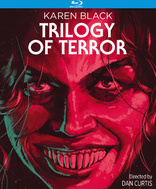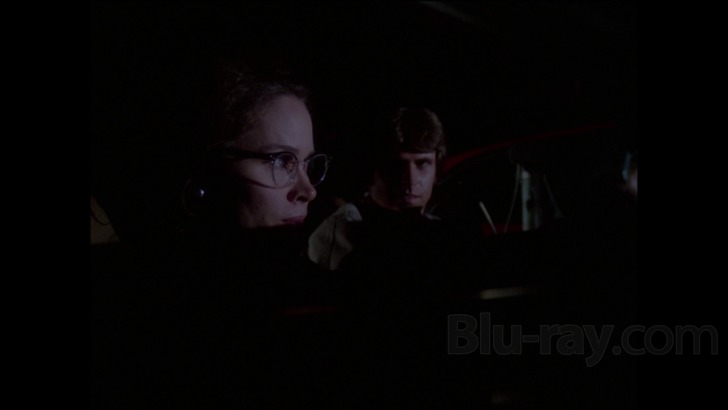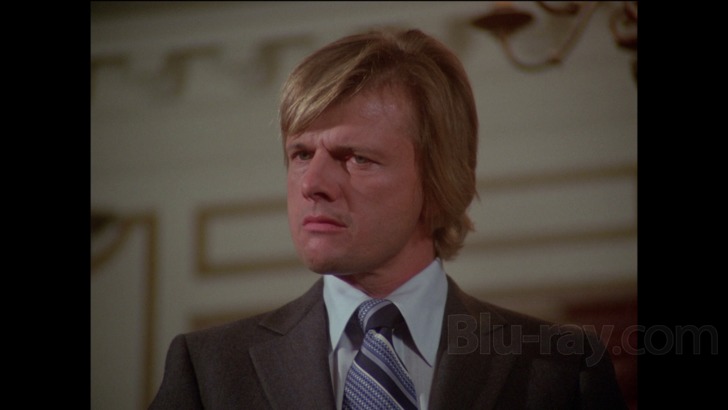Trilogy of Terror Blu-ray Movie
HomeTrilogy of Terror Blu-ray Movie 
Kino Lorber | 1975 | 72 min | Not rated | Oct 16, 2018
Movie rating
6.8 | / 10 |
Blu-ray rating
| Users | 0.0 | |
| Reviewer | 4.0 | |
| Overall | 4.0 |
Overview
Trilogy of Terror (1975)
Three tales: In "Julie," an aggressive college student seduces and ultimately blackmails his seemingly shy English professor. In "Millicent and Therese," two polar-opposite sisters become increasingly hellbent on the undoing of one another. And in "Amelia," a woman falls prey to a murderous Zuni fetish doll.
Starring: Karen Black (I), Robert Burton (III), John Karlen, George Gaynes, Jim StormDirector: Dan Curtis
| Horror | 100% |
Specifications
Video
Video codec: MPEG-4 AVC
Video resolution: 1080p
Aspect ratio: 1.34:1
Original aspect ratio: 1.33:1
Audio
English: DTS-HD Master Audio 2.0 (48kHz, 16-bit)
BDInfo
Subtitles
English SDH
Discs
25GB Blu-ray Disc
Single disc (1 BD)
Packaging
Slipcover in original pressing
Playback
Region A (locked)
Review
Rating summary
| Movie | 3.0 | |
| Video | 4.0 | |
| Audio | 4.0 | |
| Extras | 4.0 | |
| Overall | 4.0 |
Trilogy of Terror Blu-ray Movie Review
Reviewed by Brian Orndorf October 31, 2018After scoring ratings gold with 1972’s “The Night Stalker” and 1973’s “The Night Strangler,” director Dan Curtis decided to return to television with a new vision for horror entertainment on ABC, going the anthology route with 1975’s “Trilogy of Terror.” Trading the detective world of Kolchak for an extended freak-out with star Karen Black, Curtis reunites with writer Richard Matheson for tales of disturbing sexuality, mental fractures, and the menace of an African doll, coming up with a surprisingly bland stew of panicky encounters that aren’t particularly vivid, only surging with violent energy in small amounts. “Trilogy of Terror” is largely remembered by fans for its final chapter, and for good reason, as the other two are basically filler for a production that’s attempting to bring perversion and shock to network TV, not quite understanding how difficult it is to support nightmare fuel when dealing with commercial breaks and material that’s decidedly more tell than show.

In “Julie,” Chad (Robert Burton) is a college student who’s tired of lusting after his classmates, looking for a greater challenge in Julie (Karen Black), his English teacher. Hoping to seduce the timid woman, Chad has a greater plan in mind when she finally agrees to go out on a date with him, putting his photography skills and sick mind to use. “Millicent and Therese” explores the rage felt by Millicent (Black), a repressed woman who’s disgusted by the actions of her sister, Therese (Black), a wild child she claims seduced their father. Fed up with Therese’s sexual ways, Millicent turns to darker forces to achieve dominance over her sibling. And “Amelia” explores a special night for a young woman caught between her mother’s control and her love for a man, planning to gift him a special Africa warrior doll that possesses the spirit of a Zuni tribesman. When the curse protecting the doll is broken, Amelia is left in her apartment to battle the rampaging wood doll, who’s eager to slaughter her.
“Trilogy of Terror” is based on three stories by Curtis regular, Richard Matheson, only the writer takes on teleplay duties for “Amelia,” leaving the rest of the work to William E. Nolan. It’s easy to see why Matheson dodged most of this adaptation of his early work, as “Julie” and “Millicent and Therese” don’t have much dramatic shape, preferring a slightly aimless odyssey of characterization, which isn’t enough to wind up these two tales of twisted manipulation. “Trilogy of Terror” is much too talky at times, burning film on banal conversations or, in the case of “Millicent and Therese,” building to a big reveal that’s not difficult to spot in the short’s initial moments. Curtis covers the action without flair, spending too much of the first two chapters on glacial non-events that are meant to funnel into a dynamic horror show.
The one segment that survives the slumber of “Trilogy of Terror” is “Amelia,” but even that tale takes a good ten minutes to get going, with Matheson failing to inspire much suspense with a series of one-sided telephone conversations before the Zuni doll breaks free from its curse and begins to stalk the single woman. It’s strange that Black is the sole actress of the production (there’s really no need for her to take on most of the roles), but she scores her best work in “Amelia,” tasked with creating a primal battle between human and doll, working up hysterics as Amelia deals with the pint-sized menace and, apparently, some type of inner-ear difficulties, finding the character falling over repeatedly and for no reason.
Trilogy of Terror Blu-ray Movie, Video Quality 

Joining "The Night Stalker" and "The Night Strangler" in the Dan Curtis release wave on Blu-ray, "Trilogy of Terror" makes it to HD with a "Brand new 4K restoration." The AVC encoded image (1.34:1 aspect ratio) presentation is strong overall (the film is shot with a softer, hazy look), with satisfactory detail when covering close-ups, providing a textured look as skin surfaces, and clothing is fibrous, going from professional wear to evening outfits. Locations are dimensional, and interiors preserve set decoration. Zulu doll edges and aggressive design remain intact. Colors are acceptable, with period extremity doing quite well here, providing bright orange and green carpets and red fashions. Skintones are natural. Delineation is challenged but stays communicative. A few jumpy frames pass by, but the source remains free of pronounced damage.
Trilogy of Terror Blu-ray Movie, Audio Quality 

The 2.0 DTS-HD MA sound mix on "Trilogy of Terror" doesn't move beyond its television origins, supplying a simple arrangement of dialogue exchanges and scoring. Performances are secured, and while a few sibilance issues pop up, nothing prolonged is encountered, with clarity reasonable throughout the listening event. Music retains instrumentation, finding Colbert's stranger sounds supporting suspense needs without disruption. Doll effects and grunting are also a highlight, giving the little monster needed presence during attack sequences.
Trilogy of Terror Blu-ray Movie, Special Features and Extras 

- Booklet (six pages) includes an essay by Simon Abrams.
- Commentary #1 features film historian Richard Harland Smith.
- Commentary #2 features actress Karen Black and writer William E. Nolan.
- Interview (8:38, HD) sits down with composer Robert Cobert, who delves into a lengthy story of his upbringing, dealing with a family of musicians. His unwillingness to participate in piano lessons pursued him throughout his life, even when he became a film professional, often relying on others to play the instrument while he worked on scoring particulars through other means. Cobert is blunt about his relationship with director Dan Curtis, making sure to "follow his orders," with some arguments breaking out along the way, highlighting a contentious but professional collaboration.
- Interview (10:59, SD) with Richard Matheson is an unexpectedly candid 2006 conversation with the writer, who prefers to be known for "terror," not horror. A brief career overview is provided, highlighting work on "The Twilight Zone" and "The Night Stalker," and Matheson recalls his working relationship with Curtis, describing him as a man with an incredible temper but large creative drive. A discussion of "Trilogy of Terror" is included, with Matheson offering the teleplay assignments for "Julie" and "Millicent and Therese" to William F. Nolan simply because he didn't want to do them, saving "Amelia" for himself, knowing that would be the highlight of the film. The beloved writer discusses his inspirations, dismissal from the movie industry after committing the sin of aging, and dealing with a "modern" horror atmosphere of slasher entertainment.
- Interview (16:53, SD) with Karen Black (from 2006) recounts her early career, building her reputation in the theater before moving into films, scoring roles and industry heat in pictures such as "Easy Rider," "Five Easy Pieces," and "The Great Gatsby." Black offers a lengthy discussion of her character work on "Trilogy of Terror," working hard to do something with her many roles, but also criticizing a few technical limitations, including the quality of her wigs. There's also a vivid description of working with the Zulu doll puppet, which never really worked, forcing Black to come up with ways to sell the tiny tormentor. There are a few weird tangents, including Black's insistence that "Trilogy of Terror" should be classified as science fiction, and she takes credit for the final image of "Amelia," coming up with the large teeth reveal. Black seems bewildered by the movie's cult appeal, almost irritated by its longevity, openly wishing other projects she participated in were held in the same esteem.
Trilogy of Terror Blu-ray Movie, Overall Score and Recommendation 

Curtis wisely saves the best for last, sending "Trilogy of Terror" off on a high note with "Amelia," which adds an appealingly macabre ending to the segment and the picture. It's too bad there's not enough raw energy to the endeavor to make the first two chapters stand up and shout, but there's intermittent cruelty and moral corruption to enjoy as the movie tries to come up with things to do before getting to the Zuni doll and its distinct offering of visual intensity.
Similar titles
Similar titles you might also like

I Drink Your Blood
Also Includes = I Eat Your Skin and Blue Sextet
1970

The House That Dripped Blood
1971

The Amityville Murders
2018

Shriek of the Mutilated
Slipcover In Original Pressing
1974

Cauldron of Blood
Blind Man’s Bluff
1968

House of Mortal Sin
The Confessional
1976

Slime City
1988

Burn, Witch, Burn
Night of the Eagle | 4K Restoration
1962

Grave of the Vampire
1972

The House of the Devil
2009

Kingdom of the Spiders
Kino Cult #14
1977

Devil Times Five 4K
Peopletoys / Slipcover in Original Pressing
1974

Blue Sunshine 4K
1977

Weird Woman
1944

Summer of Fear
Stranger in Our House
1978

Dogs
1976

The Quiet Ones
2014

The Dark Half 4K
Slipcover in Original Pressing
1993

Asylum 4K
1972

The Possession of Joel Delaney 4K
Slipcover in Original Pressing
1972